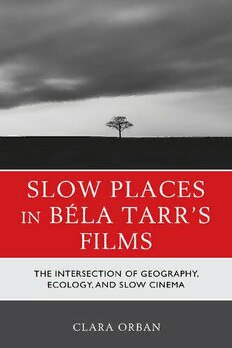
Slow Places in Béla Tarr's Films: The Intersection of Geography, Ecology and Slow Cinema PDF
Preview Slow Places in Béla Tarr's Films: The Intersection of Geography, Ecology and Slow Cinema
Slow Places in Béla Tarr’s Films Slow Places in Béla Tarr’s Films The Intersection of Geography, Ecology, and Slow Cinema Clara Orban LEXINGTON BOOKS Lanham • Boulder • New York • London Published by Lexington Books An imprint of The Rowman & Littlefield Publishing Group, Inc. 4501 Forbes Boulevard, Suite 200, Lanham, Maryland 20706 www .rowman .com 6 Tinworth Street, London SE11 5AL, United Kingdom Copyright © 2021 by The Rowman & Littlefield Publishing Group, Inc. All rights reserved. No part of this book may be reproduced in any form or by any electronic or mechanical means, including information storage and retrieval systems, without written permission from the publisher, except by a reviewer who may quote passages in a review. British Library Cataloguing in Publication Information Available Library of Congress Cataloging-in-Publication Data Names: Orban, Clara Elizabeth, 1960– author. Title: Slow places in Béla Tarr’s films : the intersection of geography, ecology and slow cinema / Clara Orban. Description: Lanham : Lexington Books, [2021] | Includes bibliographical references and index. | Summary: “This book explores Hungarian filmmaker Béla Tarr’s approach to creating geographies of indifference through slow cinema techniques. Author Clara Orban utilizes close readings of the films, relevant poems, a thorough filmography, and an interview with Tarr in her analysis”—Provided by publisher. Identifiers: LCCN 2021022455 (print) | LCCN 2021022456 (ebook) | ISBN 9781793645647 (cloth) | ISBN 9781793645654 (epub) Subjects: LCSH: Tarr, Béla, 1955—Criticism and interpretation. | Tarr, Béla, 1955—Interviews. | Motion picture producers and Directors—Hungary. Classification: LCC PN1998.3.T363 O73 2021 (print) | LCC PN1998.3.T363 (ebook) | DDC 791.43023/3092—dc23 LC record available at https://lccn .loc .gov /2021022455 LC ebook record available at https://lccn .loc .gov /2021022456 ∞ ™ The paper used in this publication meets the minimum requirements of American National Standard for Information Sciences—Permanence of Paper for Printed Library Materials, ANSI/NISO Z39.48-1992. Contents List of Illustrations vii Acknowledgments ix 1 Introduction: Tarr in the Anthropocene 1 2 Slow Cinema, Tarr’s Places, and Hungarian Cinema 15 3 The Claustrophobic Indoors 41 4 The Empty Outdoors 81 5 Animals 107 6 Short Films and Segments: Further Experimentation 125 7 Conclusion: Visions of Loneliness 145 Appendix A: Petőfi Poems 151 Appendix B: Transcript of Interview with Béla Tarr 171 Filmography 179 Bibliography 193 Index 201 About the Author 209 v List of Illustrations Figure 1.1 Maloin with the Signal Box in the Background 10 Figure 2.1 Claudia and Sandro with Etna in the Background 22 Figure 2.2 A Crosswalk That Becomes an Abstract Figure 24 Figure 3.1 The Television in Family Nest 49 Figure 3.2 The Cluttered Apartment in the Background 51 Figure 3.3 The Pullout Couch, Tennis Racket, and Objects 52 Figure 3.4 The Washing Machine Ride 54 Figure 3.5 The Stone Walls behind the Unhappy Couple 56 Figure 3.6 Objects in the Bourgeois Apartment 57 Figure 3.7 Washing in the Hut 64 Figure 3.8 Eclipse in the Kocsma 70 Figure 3.9 The Asylum 74 Figure 4.1 An Elegant Square and a Whale Trailer 89 Figure 4.2 Irimiás and Petrina in the Forest 96 Figure 4.3 Coal Buckets Out the Window 98 Figure 4.4 Wind and a Well 101 Figure 5.1 The Coal Pit Pack 111 Figure 5.2 Cows 115 Figure 5.3 Chickens in Budapest 120 Figure 5.4 A Birdcage by a Window 123 Figure 6.1 Tension in the Hotel 127 Figure 6.2 The Open Road 130 Figure 6.3 A Ruined Church and Field 130 Figure 6.4 Waiting for a Handout 141 vii Acknowledgments This project comes from a very personal space: my love of the arts and litera- ture, my love of cinema, and my Hungarian roots. As a professor of Italian and French, I began working on cinema as part of my scholarly interest. I was able to teach courses on Italian films at DePaul University, which led me to delve more deeply into Michelangelo Antonioni’s works, among others. My Italian heritage has always been entwined with my professional aspirations and thanks to my mother’s enthusiasm and passion for the arts it became a calling for me. My Hungarian roots were less prominently influential in my professional life, given the simple fact that Italian was the language we spoke at home, while my contact with Hungarian was limited to moments when my father talked to his siblings, or when we attended events in the Chicago Hungarian community. My interest in Hungarian started there, but it was not until adulthood that I accelerated my Hungarian exploration. I was first introduced to Béla Tarr’s films at Facet Multimedia in Chicago, one of the premiere art house theaters that showed Werckmeister Harmonies when it first came out. This film was a revelation. Already interested in Antonioni’s cinema, I realized an affinity between the two directors. It was not until later, upon reading the increasing materials about slow cinema, that I made the connection. I loved both these filmmakers because they made films that were like books. While Hollywood exploited film’s potential for move- ment and fast pacing to the extreme, these filmmakers and others like them demanded that we take our time to really see what was in front of us. They brought pacing back to a level where contemplation can replace adrenaline rush in helping the mind synthesize images. I continue to discover new films, new filmmakers, and new approaches that are witness to this tradition of emphasizing the “art” in art house cinema. ix
